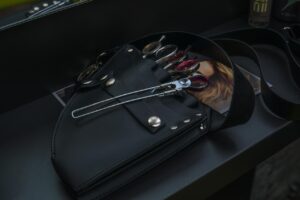Easy, Confident Cuts: Clippers for Curly & Coily Hair
Clippers are often seen as a barber’s-only tool, but they’re perfect for beginners working with curly and coily textures. With the right technique, you can get fast, consistent results that respect curl shape and prevent damage. This guide shows simple, practical steps and clear gear choices to keep things NO-FUSS and safe.
You’ll learn how texture, density, and shrinkage change your clipper approach, plus easy beginner cuts, blending tips, and aftercare. Follow these step-by-step instructions and you’ll cut with confidence, avoid common mistakes, and maintain great results at home.
No prior experience is needed — basic safety, blade care, and simple guard choices make this achievable. Read on, start slowly, and celebrate small wins as your skills improve every time.




WAHL Vapor Clipper Review: Quiet Power and Precise Trims
Gather the Right Tools: Clipppers, Guards, Combs and Prep Gear
Clippers: corded vs cordless
Corded clippers give constant power for long sessions; cordless models add freedom and are easier to angle around tight curls. For textured hair, choose a model with strong torque—clippers that stall on thick sections will snag and pull. If you plan quick trims, cordless is more user-friendly; for longer, thicker cuts, plug-in power is steadier.
Essential guards and what they mean
Use guards to control length precisely. Common sizes (approximate finished length):
Curly/coily hair shrinks, so pick a longer guard than you think. Start longer, work shorter.
Useful attachments
Combs, brushes and prep gear
Minimal kit for KD < 20 and low-cost swaps
For a tight budget: one reliable cordless clipper, a set of basic guards (#1–#4), a wide-tooth comb, spray bottle, 4 clips, and a towel. Multipurpose items (use a kitchen towel as a cape; an inexpensive trimmer can serve as a detailer) keep costs down while staying effective for textured hair. Practicality beats gadget overload—start simple and upgrade based on what your hair really needs.
Know Your Curls: How Texture, Density and Shrinkage Affect Clipper Cuts
Texture & curl tightness (practical, not just labels)
Think in terms of how the hair behaves when cut. Looser curls (wide S-shapes) lay flatter and show length more easily. Tighter coils (Z-shaped, tightly packed) spring up fast and look shorter. That spring-back changes how short a guard appears after the cut—so treat the curl pattern as a measurement of behavior, not a name.
Density and spring-back: choose guards accordingly
High-density hair (lots of strands per square inch) fills in quickly and can hide clipper lines; low-density hair shows mistakes sooner.
Shrinkage and perceived length
Shrinkage can be 30–70% depending on tightness and moisture. A 1″ coil can look like ½” after drying. Do a quick reality check: stretch one curl to its full length and compare it to its resting length to estimate shrinkage before choosing a guard.
Growth direction, cowlicks and parting patterns
Growth direction changes how clippers lay hair down. Cowlicks and swirling patterns resist clean lines; you’ll need to approach them at an angle or leave slightly longer there to avoid uneven strips. When in doubt, clip with the grain first (same direction as growth), then refine against the grain for clean edges.
Quick tests before you cut
Next up: learn the clipper basics—guard math, motor speeds and blade care—to turn these observations into confident, consistent cuts.
Clipper Basics: Guards, Speeds and Blade Care for Textured Hair
Understanding guard numbers (what they actually leave behind)
Guards are shorthand for length, but on curly/coily hair the visual result is shorter than the raw measurement. Standard guide:
Choosing guard increments for smooth transitions
Smaller steps = cleaner blends. For textured hair:
Clipper speeds and motor types
Slower speeds are gentler: they reduce pull, heat and the snap that makes coils bounce into uneven stubbles. Start at low–medium on dense/coily hair and only increase if the motor isn’t cutting through. Rotary motors (e.g., Wahl Magic Clip) handle density better than light magnetic motors; if your clipper stalls, that’s a sign to slow down or switch tools.
Blade care: cleaning, oiling & warming
Keep blades clean and oiled to prevent tugging and irritation. Brush out clippings, remove the blade for a deeper clean, and add a few drops of oil to the teeth before a session and every 20–30 minutes of use. Run the clipper for 30–60 seconds before cutting to warm the blades (test on your wrist first).
Quick troubleshooting & when to switch tools
Next, we’ll walk through step-by-step beginner-friendly clipper cuts that put these basics into practice.
Step-by-Step: Easy Clipper Cuts for Beginners
Stage 1 — Prep & section
Start with clean, slightly damp hair so coils relax but don’t stick. Use a wide-tooth comb to detangle and define where the sides meet the top. Pin or clip the top section up if you plan a shorter sides/longer top look. Quick real-world tip: when I first tried a DIY cut on a friend with 4C hair, sectioning saved hours — and a frantic fix later.
Stage 2 — Pick your guard and test
Always start one guard longer than your target length. Test on a small patch at the nape to see how coils spring back — remember shrinkage. Stop, comb, reassess if the test looks too short.
Stage 3 — Clip the sides with the grain
Go with the hair growth direction to avoid uneven stubble. Hold the clipper flat against the head and use smooth, overlapping strokes from bottom to top. Work in short passes, clear clippings often, and keep the skin slightly taut.
Stage 4 — Clip the top (even length or longer top)
Even top: attach the same guard and cut with the clipper, combing each section forward before cutting. Longer top: leave a larger guard or switch to scissor-over-comb for textured finish and more control. If you want visible curl definition, stop early — you can always take more later.
Safety cue: every 4–6 passes, stop and comb the area to check for missed spots.
Stage 5 — Taper the neckline & clean up
Soft taper: step down guards gradually (e.g., #3 → #2 → #1) as you move down the nape. Skin fade: switch to a trimmer for a close finish, but approach slowly and mirror-check frequently. Finish edges around ears and the hairline with a detail trimmer.
Final safety reminders: pause often, comb and view from different angles, and if something looks uneven, revert to a longer guard and correct in small increments.
Managing Problem Areas: Cowlicks, Patchiness, and Uneven Growth
Tame cowlicks and hair that changes direction
Cowlicks are about angle, not force. Angle the clipper so the blade follows the local growth direction — a slight tilt can flatten a stubborn swirl. Use short, shallow passes and finish with clipper-over-comb for control: lift the hair with a comb, rest the clipper teeth on the comb, and trim tiny amounts until the cowlick blends.
Real-world tip: I once corrected a strong crown swirl by working from several directions and finishing with a #2 guard over the comb — the swirl disappeared without shaving the whole area.
Camouflage thin spots with blending and texture
Thin spots look fuller when surrounded lengths are blended and textured. Keep a slightly longer guard over the thin area, then:
A small amount of length (1/4–1/2 inch) can create the illusion of density when properly blended.
Handle uneven growth patterns slowly
Uneven growth calls for matching the surrounding lengths rather than fixing the low spot immediately. Work in small increments:
Quick fixes for mistakes
If you create an accidental high line:
Next up: learn pro finishing moves — blending, clean edging, and at-home aftercare to make your work last.
Finish Like a Pro: Blending, Edging, Aftercare and At-Home Maintenance
Smooth blends without harsh steps
For a polished look, move in small guard increments (for example, #2 to #1.5) and use clipper-over-comb to soften any banding. Work with the natural curl direction and make short, controlled passes — the goal is gradual graduation, not a single aggressive cut. If a line appears, stop, lift with the comb, and trim millimeters at a time until it disappears.
Clean, natural-looking edges
Use a T-blade trimmer or detailer to outline hairlines gently. Avoid shaving too close on curly/coily textures to prevent ingrown hairs and a “too-sharp” look. When shaping a soft, natural hairline:
Aftercare for freshly cut curls
Blow off clipper dust with a soft brush, then rinse or wash with a gentle, sulfate-free cleanser. Follow with a moisturizing leave-in or curl cream and seal with a light oil (shea butter, jojoba, or a blend) to lock in shine and reduce frizz. Avoid heavy gels that flatten coils right after a cut.
Simple at-home maintenance
Practice plan & when to get help
Practice once a week for 6–8 weeks: start with simple blends, add edging in week three, and attempt texture changes by week five. Work on a mannequin or a forgiving friend first. Seek a pro for complicated fades, major crown corrections, significant thinning, or if you’re nervous about changing your hairline — a stylist experienced with textured hair can save time and hair.
Ready for the final wrap-up and next steps?
Wrap-Up and Next Steps
Preparation, knowing your curl type, and safe clipper use are the pillars of successful at-home cuts. Follow the stepwise beginner cuts, use proper guards and combing, and keep blades clean. Start with conservative lengths and test small sections so you learn how density and shrinkage respond.
Be patient and practice — small, careful changes beat rushing every time. Use this guide as a checklist for your first few attempts, and refine blending, edging, and aftercare each time. When in doubt, pause, reassess, and trim less. Enjoy learning; better at-home cuts come with steady, confident repetition and thrive.









Quick product shout: Wahl Premium Blade Lubricating Oil 4oz is tiny but goes a long way. If you’re serious about at-home maintenance, that oil + a cleaning brush should be in every kit.
Also: is there any downside to using corded vs cordless on thick, coily hair?
Corded for power, cordless for convenience. I keep both and use corded for longer sessions.
No major downside — corded clippers often deliver consistent power (good for thick hair), but you lose mobility. If you cut multiple heads in a row or have very dense hair, corded can be preferable.
The ‘Know Your Curls’ breakdown was gold. Density vs texture explained simply. I had no idea shrinkage would change the guard choice so drastically.
Also, tiny typo on page 4 (guards spelled as ‘clipppers’ once) — no big deal but made me giggle.
Hah spotted that too. Nothing wrong with a little proofreading hunt while learning to cut hair.
Thanks for the eagle-eye! We’ll fix the typo — appreciate the heads-up (and glad the density tips helped).
Typos are proof humans wrote it — I like that. 😉
Also, shrinkage experiments = best learning. Clip a small patch, let it settle, then decide guard. Saved me from tragic mistakes.
Question: the article mentions the Ufree Titanium T-Blade for edging — does that work well on curly hair without ripping? I have a sensitive scalp and hate that tugging feeling.
The Ufree Titanium T-Blade is designed for precision; many readers report cleaner lines with less tug. Key is keeping the blade clean and lubed — dry blades can pull. Also use light pressure and let the blade do the work.
Also consider trimming right after a warm shower — hair is softer and easier to edge (but don’t do major cuts wet if you care about shrinkage!).
I use the Ufree for fine details and it’s been gentle. If you’re worried, try the blade on a small area first or use it towards the end when most hair is already removed.
Plus, if you pair it with the Wahl Premium Blade Oil it’s a smoother glide. Not magic, but helps a lot.
Not gonna lie, the humor in a couple of side notes made me chuckle. 😂 The ‘don’t panic’ line when it looks uneven saved my confidence mid-cut.
I’ve been experimenting with speeds: the Wahl Lithium Ion Pro has noticeably different torque than cheaper cordless clippers. Worth the upgrade if you do frequent cuts.
Agree about torque — saved my salon-grade trimmer for the thickest sections and used a lighter cordless elsewhere.
Both torque and ergonomics matter — choose based on hair density and how many cuts you’ll do in one sitting.
Also battery life on the Lithium models is legit. No more cutting with one eye on the power indicator.
Glad you enjoyed the tone! And yes, investing in a higher-torque clipper reduces snagging on dense areas, which makes the whole process less stressful.
Torques matters but hand fatigue matters too — lighter clippers (even slightly less torque) can be easier for long sessions.
The ‘Finish Like a Pro’ part was actually my favorite. Blending used to terrify me, but the slow, small strokes + using the 0.5 guard trick on edges made my fades look 10x better.
Also loved the aftercare: keeping scalp moisturized and avoiding heavy grease that clumps curls.
I like a light water-based moisturizer or a few drops of argan oil applied sparingly. Works well for dense coils.
Yes — gentle blending and aftercare are often overlooked but make the haircut look intentional and fresh for longer. Thanks for sharing your experience!
I’ve been using light leave-in conditioner after trims. It helps curls lay nicely without weighing them down.
Which products do you use for moisturization that don’t make the scalp too greasy?
Neutral take: article is useful but felt a bit long in spots. Maybe add a TL;DR checklist for the ‘Gather the Right Tools’ section — like a printable one-page shopping list for beginners.
Otherwise, good coverage of basic techniques and the product suggestions were on point.
I made my own quick checklist and taped it to the kit: clippers, guards, blade oil, combs, cape. Saved me from multiple trips to the store 😅
Thanks — a one-page checklist is a helpful suggestion. We’ll consider adding a downloadable checklist in the wrap-up section.
Loved the “Easy, Confident Cuts” section — finally something that doesn’t assume all curls behave the same. I grabbed the Wahl Color Pro Cordless for my brother’s 4C hair and it’s been surprisingly gentle. The color-coded guards are a lifesaver.
Question: anyone used the 10 Color-Coded Professional Clipper Guards with the Wahl Lithium Ion Pro? Wondering if the fit is universal or if I should stick to Wahl-branded guards. Also, that blade oil tip saved me — thanks!
Great to hear it helped! The 10 color-coded guards you mentioned are generally compatible with most Wahl clippers, especially the Lithium Ion Pro, but sometimes fit varies slightly. If you notice any wiggle, the Wahl-specific guards are the safest bet.
I use the pro guards with the Lithium Ion Pro and they fit fine for me. Only thing: store the organizer upright or the clips fall out 😅
If you want zero risk, grab the Wahl Home Corded Clipper Kit for backup — cheaper and you get matching guards. But if portability matters, stick with the Lithium and the color-coded set.
I appreciated the section on cowlicks. My son’s cowlick near the crown used to ruin every at-home cut. The trick of following natural growth and then blending around it actually worked. 🙌
Small note: the diagrams would’ve been better with more angles, but still super helpful.
Same — I had to learn to ’embrace’ the cowlick and cut around it instead of forcing it flat. It saved a lot of frustration.
Thanks for the feedback! We’ll think about adding more angles/screenshots. Glad the growth-following approach helped with the cowlick.
This article is probably the clearest guide I’ve seen for first-timers. Step-by-step was super practical — I followed the ‘Start long, go short’ advice and didn’t freak out when things looked uneven at first.
I used the Wahl Premium Blade Lubricating Oil 4oz after the first pass and the clippers ran WAY smoother. Pro tip: clean the blade with a small brush and then oil every 20 minutes of cutting.
Also, if you have patchy spots, try the blending tips in the ‘Managing Problem Areas’ section. A 0.5 guard and light feathering helped hide a birthmark-ish thin area on my scalp.
I second the ‘start long’ advice. I messed up once by going too short and had to grow it out for months 😂
Love that tip, Sofia — regular oiling really prolongs blade life and keeps cuts consistent. Glad the step-by-step helped!
I used the Solati kit — battery life was great and it felt lighter in hand. Wahl felt chunkier but was a bit more powerful on dense hair.
Which Solati kit model did you use? I’m choosing between the Solati Professional Cordless and the Wahl Lithium Ion Pro.
I tried doing a full DIY after reading the guide and — oof — edging is still my nemesis. The Ufree T-Blade helped a lot with precision, but I think I need more practice.
Anyone got recommended short practice routines? Maybe practice on a wig head first?
Start with just the neckline and sideburns each time rather than a whole head. Small wins build confidence.
I practiced on my partner’s hair for a few sessions — lower stakes and you get feedback. Wig heads are great too for repetitive practice.
Practice on a wig head or an old cushion (with a hairpiece) is a good start. Focus 10 minutes a day on edging lines and blending small sections to build muscle memory.
I appreciate the balanced product mentions: Wahl, Solati, Ufree — gave me options at different price points. Ended up getting the Wahl Lithium Ion Pro and the organizer guards — feels like a mini salon now.
One silly comment: my cat loved the organizer more than I did. Guess I’m not the only one into color-coding 😂
Pictures please! Would love to see your setup. Cats + clippers = entertainment and chaos.
If the cat naps on the organizer, at least your guards are warm when you need them 😆
Ha! Pets and tools often bond. Glad the product roundup helped you pick — enjoy your mini salon (and maybe keep the cat away during cuts).
If you’re new, grab the Wahl Home Corded Clipper Kit and the 10 color-coded guards combo. Corded is a reliable backup when batteries die mid-cut. Not sexy, but practical.
Also, don’t forget to clean hair out of the guard organizer after each session — little hairs collect and make guards stick.
I use compressed air too for the organizer — works wonders. But careful in small apartments, that stuff spreads everywhere 😂
Solid practical advice. Corded kits are underrated. Good call on cleaning the organizer — tiny detail, big difference.
Pro tip: keep an old toothbrush near your kit to brush out guards, blades, and the organizer. Cheap and effective.
Really liked the clipper speeds section. I learned that textured hair often needs lower RPM to avoid puffing out the curls — who knew? Tried slowing my Solati clippers down and it actually reduced frizz on my coily sections.
Minor gripe: would’ve loved a quick chart mapping guard sizes to visible length on shrinkage-prone hair.
Yep. I make a small test cut in a hidden spot first. That tells me exactly how much shrinkage to expect — saved me from a few too-short mishaps.
Good point, Marcus — a shrinkage chart is a great idea for a future update. For now, a good rule is to subtract about 25-40% from the expected length on tight coils, depending on density.